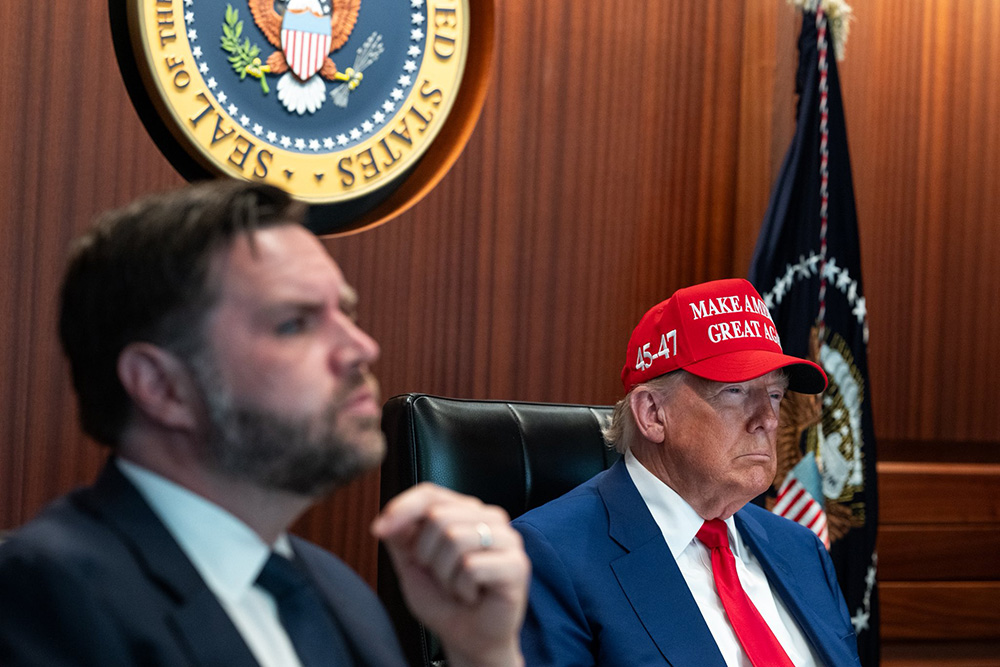In a dramatic escalation of military action, Secretary of Defense Pete Hegseth announced that the United States successfully carried out a precision strike on three key nuclear facilities in Iran on President Trump’s orders. The early morning operation targeted sites in Fordow, Natanz, and Esfahan, aims to effectively dismantle Iran’s nuclear program and reaffirm American military prowess on the global stage.
During a press briefing, Hegseth declared that the operation, conducted by U.S. Central Command, was an overwhelming success, meticulously planned and executed under the command of General Eric Kurilla. He emphasized that the focused and powerful strike was not aimed at Iranian troops or civilians, reiterating the U.S. commitment to preventing Iran from acquiring nuclear weapons—a stance President Trump has maintained for over a decade.
“This operation devastated the Iranian nuclear program,” Hegseth stated, highlighting the meticulous preparations that preceded the strike. He lauded the execution as a demonstration of “American deterrence” and a clear message that the U.S. military stands ready to act decisively when its national interests or its allies are threatened.
Hegseth praised Trump’s leadership as bold and visionary, asserting that the operation delivered a decisive blow to Iran’s nuclear ambitions that had eluded previous administrations. “Many presidents have dreamed of delivering the final blow to Iran’s nuclear program, and none could, until President Trump,” he said, reinforcing the notion that achieving this goal required exceptional military acumen and strategic foresight.
The operation, dubbed “Operation Midnight Hammer,” involved the longest B-2 Spirit bomber mission since 2001 and marked the first operational use of the Massive Ordnance Penetrator (MOP), designed to penetrate deeply buried targets. Hegseth noted the strike’s exceptional precision, stating that U.S. forces were able to execute the mission without the world being aware of their movements—an achievement reflecting high operational security.
General Dan Caine, the Chairman of the Joint Chiefs of Staff, corroborated Hegseth’s statements, expressing gratitude to the service members involved in the mission. “Their actions reflect the highest standards of the United States Armed Forces,” he stated, underscoring the teamwork and discipline required to successfully execute such a complex operation.
Caine described the strike as a complex and high-risk mission that was executed with remarkable skill across multiple domains and theaters. He emphasized that the primary goal of the operation was to significantly degrade Iran’s nuclear weapons infrastructure, thereby reducing the nation’s ability to develop and deploy nuclear arms in the future.
In light of the operation’s success, Hegseth took a firm stance against any potential retaliation from Iran, referencing a message from President Trump. “Any retaliation by Iran against the United States of America will be met with force far greater than what was witnessed tonight,” he said, calling on Iran to heed the President’s warning. Hegseth’s tone indicated that the U.S. is ready to respond decisively to any threats to its interests or those of its allies.
This operation also involved significant coordination with U.S. allies, particularly Israel, emphasizing the collaborative efforts that have been ongoing to ensure operational success. Hegseth noted the months of planning that went into positioning forces and enabling a swift response following the President’s directive.
As the briefing concluded, Hegseth expressed his admiration for the troops involved, recognizing the pilots of bombers and fighters, sailors on ships, and soldiers on the ground who contributed to the mission’s success. “Every American involved in this operation performed flawlessly,” he stated, underscoring the bravery and effectiveness of the U.S. Armed Forces.
In a nation still grappling with the implications of military actions abroad, the success of Operation Midnight Hammer represents a significant moment for the Trump administration in its foreign policy approach regarding Iran. By demonstrating military resolve, the U.S. aims to not only deter potential aggression from Iran but also to reassure allies in the region of its commitment to ensuring stability and curbing nuclear proliferation.
As tensions with Iran remain high, the aftermath of this operation will be closely watched on the international stage. The U.S. has reiterated that it does not seek war, but is prepared to act decisively in defense of its interests and those of its allies, leaving the world to ponder the broader implications of such a bold military maneuver in one of the world’s most volatile regions.






